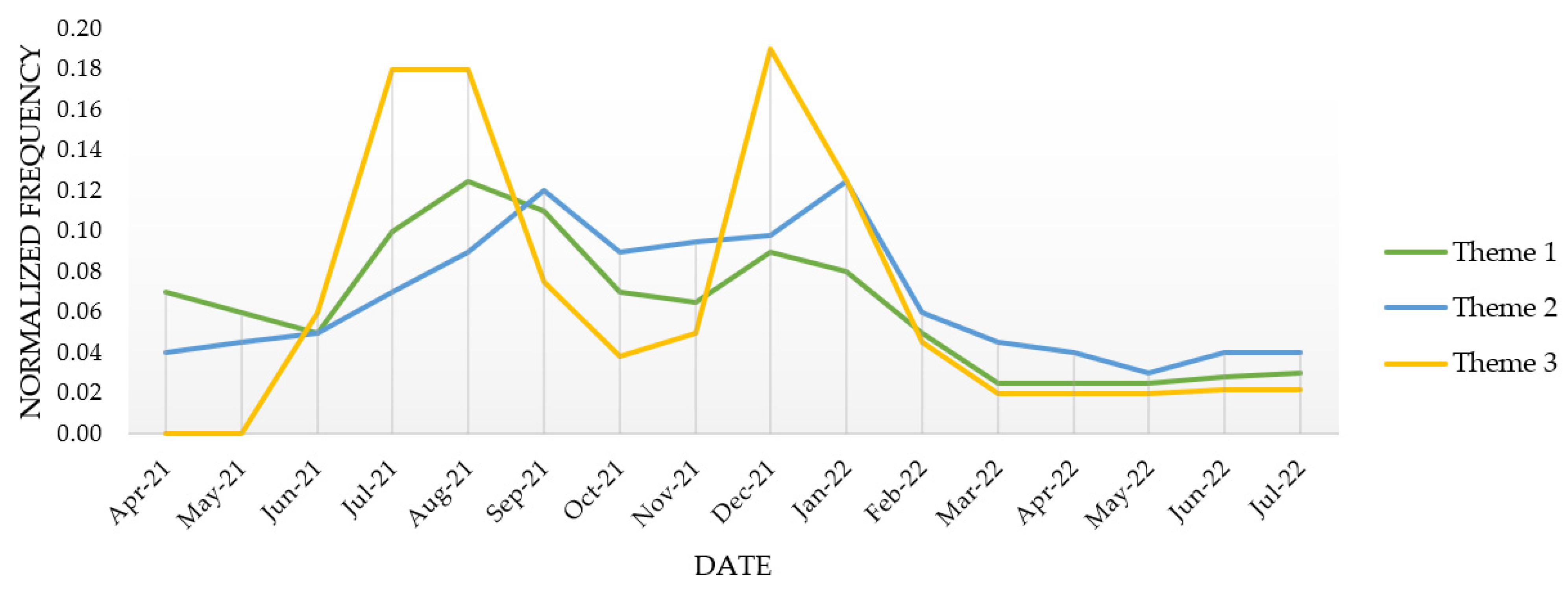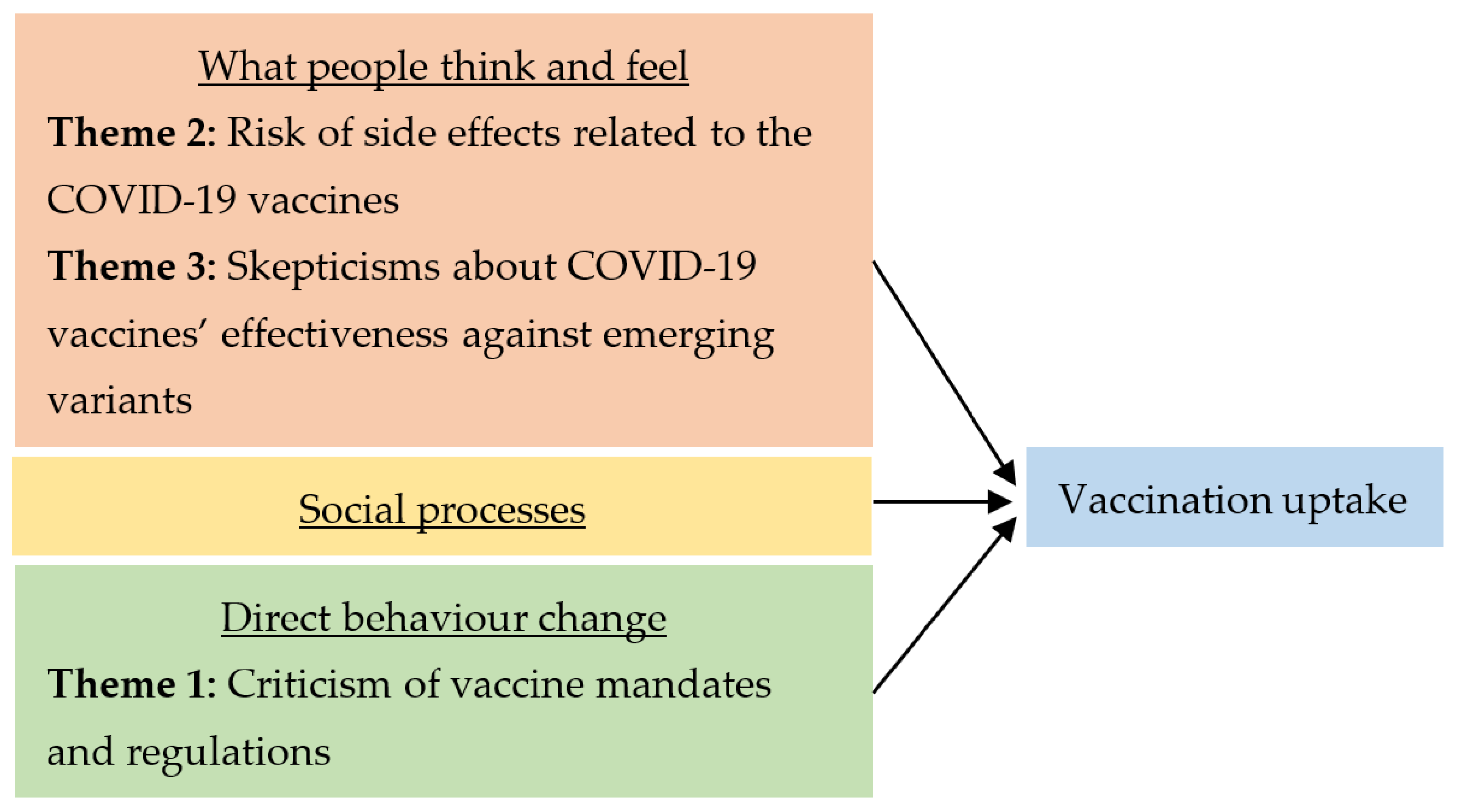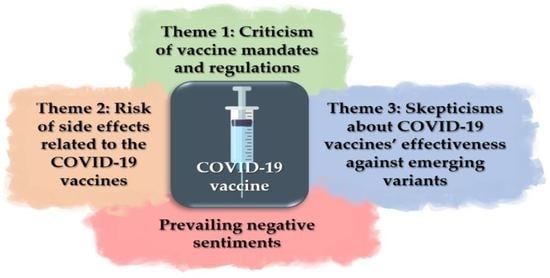Examining the Prevailing Negative Sentiments Related to COVID-19 Vaccination: Unsupervised Deep Learning of Twitter Posts over a 16 Month Period
Abstract
:1. Introduction
2. Methods
2.1. Study Design and Sample
2.2. Natural Language Processing and Thematic Analysis
3. Results
4. Discussion
5. Conclusions
Author Contributions
Funding
Institutional Review Board Statement
Informed Consent Statement
Data Availability Statement
Conflicts of Interest
References
- Lin, D.Y.; Gu, Y.; Wheeler, B.; Young, H.; Holloway, S.; Sunny, S.K.; Moore, Z.; Zeng, D. Effectiveness of COVID-19 Vaccines over a 9-Month Period in North Carolina. N. Engl. J. Med. 2022, 386, 933–941. [Google Scholar] [CrossRef]
- Liew, T.M.; Lee, C.S. Examining the Utility of Social Media in COVID-19 Vaccination: Unsupervised Learning of 672,133 Twitter Posts. JMIR Public Health Surveill. 2021, 7, e29789. [Google Scholar] [CrossRef] [PubMed]
- Yousefinaghani, S.; Dara, R.; Mubareka, S.; Papadopoulos, A.; Sharif, S. An analysis of COVID-19 vaccine sentiments and opinions on Twitter. Int. J. Infect. Dis. 2021, 108, 256–262. [Google Scholar] [CrossRef] [PubMed]
- Balakrishnan, V.; Zhen, N.W.; Chong, S.M.; Han, G.J.; Lee, T.J. Infodemic and fake news—A comprehensive overview of its global magnitude during the COVID-19 pandemic in 2021: A scoping review. Int. J. Disaster Risk Reduct. 2022, 1, 103144. [Google Scholar] [CrossRef] [PubMed]
- Piedrahita-Valdés, H.; Piedrahita-Castillo, D.; Bermejo-Higuera, J.; Guillem-Saiz, P.; Bermejo-Higuera, J.R.; Guillem-Saiz, J.; Sicilia-Montalvo, J.A.; Machío-Regidor, F. Vaccine Hesitancy on Social Media: Sentiment Analysis from June 2011 to April 2019. Vaccines 2021, 9, 28. [Google Scholar] [CrossRef]
- Our World in Data. Coronavirus Pandemic (COVID-19). 2022. Available online: https://ourworldindata.org/covid-vaccinations (accessed on 12 July 2022).
- Rahmanti, A.R.; Chien, C.H.; Nursetyo, A.A.; Husnayain, A.; Wiratama, B.S.; Fuad, A.; Yang, H.C.; Li, Y.C. Social media sentiment analysis to monitor the performance of vaccination coverage during the early phase of the national COVID-19 vaccine rollout. Comput. Methods Programs Biomed. 2022, 221, 106838. [Google Scholar] [CrossRef]
- Vargas, A.N.; Maier, A.; Vallim, M.B.R.; Banda, J.M.; Preciado, V.M. Negative Perception of the COVID-19 Pandemic Is Dropping: Evidence From Twitter Posts. Front. Psychol. 2021, 12, 737882. [Google Scholar] [CrossRef]
- Nehal, K.R.; Steendam, L.M.; Campos Ponce, M.; van der Hoeven, M.; Smit, G.S.A. Worldwide Vaccination Willingness for COVID-19: A Systematic Review and Meta-Analysis. Vaccines 2021, 9, 1071. [Google Scholar] [CrossRef]
- Devlin, J.; Chang, M.W.; Lee, K.; Toutanova, K. Bert: Pre-training of deep bidirectional transformers for language understanding. arXiv 2018, arXiv:1810.04805. [Google Scholar]
- Dslim/Bert-Base-NER Hugging Face. Huggingface.co. 2022. Available online: https://huggingface.co/dslim/bert-base-NER (accessed on 15 July 2022).
- Hartmann, J.; Heitmann, M.; Siebert, C.; Schamp, C. More than a Feeling: Accuracy and Application of Sentiment Analysis. Int. J. Res. Mark. 2022, in press. [Google Scholar] [CrossRef]
- Grootendorst, M. BERTopic: Neural topic modeling with a class-based TF-IDF procedure. arXiv 2022, arXiv:2203.05794. [Google Scholar]
- Braun, V.; Clarke, V. Using thematic analysis in psychology. Qual. Res. Psychol. 2006, 3, 77–101. [Google Scholar] [CrossRef] [Green Version]
- Burke, P.F.; Masters, D.; Massey, G. Enablers and barriers to COVID-19 vaccine uptake: An international study of perceptions and intentions. Vaccine 2021, 39, 5116–5128. [Google Scholar] [CrossRef] [PubMed]
- Edelman, A.; Marten, R.; Montenegro, H.; Sheikh, K.; Barkley, S.; Ghaffar, A.; Dalil, S.; Topp, S.M. Modified scoping review of the enablers and barriers to implementing primary health care in the COVID-19 context. Health Policy Plan. 2021, 36, 1163–1186. [Google Scholar] [CrossRef]
- Brewer, N.T. What works to increase vaccination uptake. Acad. Pediatrics 2021, 21, S9–S16. [Google Scholar] [CrossRef]
- Ling, R.R.; Ramanathan, K.; Tan, F.L.; Tai, B.C.; Somani, J.; Fisher, D.; MacLaren, G. Myopericarditis following COVID-19 vaccination and non-COVID-19 vaccination: A systematic review and meta-analysis. Lancet Respir. Med. 2022, 10, 679–688. [Google Scholar] [CrossRef]
- D’Errico, S.; Zanon, M.; Concato, M.; Peruch, M.; Scopetti, M.; Frati, P.; Fineschi, V. “First Do No Harm”. No-Fault Compensation Program for COVID-19 Vaccines as Feasibility and Wisdom of a Policy Instrument to Mitigate Vaccine Hesitancy. Vaccines 2021, 9, 1116. [Google Scholar] [CrossRef]
- Chou, W.S.; Budenz, A. Considering Emotion in COVID-19 Vaccine Communication: Addressing Vaccine Hesitancy and Fostering Vaccine Confidence. Health Commun. 2020, 35, 1718–1722. [Google Scholar] [CrossRef]
- Kubin, E.; Puryear, C.; Schein, C.; Gray, K. Personal experiences bridge moral and political divides better than facts. Proc. Natl. Acad. Sci. USA 2021, 118, e2008389118. [Google Scholar] [CrossRef]
- Elisha, E.; Guetzkow, J.; Shir-Raz, Y.; Ronel, N. Suppressing Scientific Discourse on Vaccines? Self-perceptions of researchers and practitioners. HEC Forum 2022, 19, 1–19. [Google Scholar] [CrossRef]
- Pajon, R.; Doria-Rose, N.A.; Shen, X.; Schmidt, S.D.; O’Dell, S.; McDanal, C.; Feng, W.; Tong, J.; Eaton, A.; Maglinao, M.; et al. SARS-CoV-2 Omicron Variant Neutralization after mRNA-1273 Booster Vaccination. N. Engl. J. Med. 2022, 386, 1088–1091. [Google Scholar] [CrossRef] [PubMed]
- Mills, M.C.; Rüttenauer, T. The effect of mandatory COVID-19 certificates on vaccine uptake: Synthetic-control modelling of six countries. Lancet Public Health 2022, 7, e15–e22. [Google Scholar] [CrossRef]
- Bardosh, K.; de Figueiredo, A.; Gur-Arie, R.; Jamrozik, E.; Doidge, J.; Lemmens, T.; Keshavjee, S.; Graham, J.E.; Baral, S. The unintended consequences of COVID-19 vaccine policy: Why mandates, passports and restrictions may cause more harm than good. BMJ Global Health 2022, 7, e008684. [Google Scholar] [CrossRef] [PubMed]
- De Figueiredo, A.; Larson, H.J.; Reicher, S.D. The potential impact of vaccine passports on inclination to accept COVID-19 vaccinations in the United Kingdom: Evidence from a large cross-sectional survey and modeling study. EClinicalMedicine 2021, 40, 101109. [Google Scholar] [CrossRef]
- Oilers’ Josh Archibald out Indefinitely with Heart Condition. Sportsnet.ca. 2022. Available online: https://www.sportsnet.ca/nhl/article/oilers-josh-archibald-indefinitely-heart-condition/ (accessed on 15 July 2022).
- Taboada, M.; Brooke, J.; Tofiloski, M.; Voll, K.; Stede, M. Lexicon-based methods for sentiment analysis. Comput. Linguist. 2011, 37, 267–307. [Google Scholar] [CrossRef]
- Broniatowski, D.A.; Jamison, A.M.; Qi, S.; AlKulaib, L.; Chen, T.; Benton, A.; Quinn, S.C.; Dredze, M. Weaponized health communication: Twitter bots and Russian trolls amplify the vaccine debate. Am. J. Public Health 2018, 108, 1378–1384. [Google Scholar] [CrossRef] [PubMed]




| Theme And Topic (Keywords) | Sample Tweets | Number of Tweets, n (%) |
| Theme 1: Criticism of vaccine mandates and regulations | ||
| Topic 1: Criticisms on the introduction of COVID-19 vaccine “passports” (mask, Biden, Trump, wear, variants, home, COVID deaths, Americans, experimental, FDA) | “Were it for a lethal virus I might understand your viewpoint but covid has a very low IFR and most who catch it only have mild symptoms. Mandating/coercing people to take the vaccine is unwarranted and unethical. Vax passports, a form of coercion, even more so.” | 3,939,735 (88.6) |
| Topic 2: Citing unfair treatment of unvaccinated athletes (players, NFL, athletes, team, game, player, games, vaccinated players, football, NBA) | “This is wrong for so many for moral reasons. I hope the players refuse to play, you shouldn’t be threatened over a vaccine. It’s their choice. Unvaccinated players may face $14,650 fine from the league every time they violate COVID-19 procedures.” | 61,556 (1.4) |
| Theme 2: Risk of side-effects related to the COVID-19 vaccines | ||
| Topic 3: Misinformation regarding vaccine side-effects (woman, mask, Trump, stupid, thinks, vaxxer, nurse, anti-vaxxer, job, positive COVID) | “My relatives who were vaccinated died when they got COVID! The ones who got the antibodies lived when they got COVID! She is full of shit along with the FDA and Fauci!” | 54,447 (1.2) |
| Topic 4: Risk of heart inflammation induced by the COVID-19 vaccines (myocarditis, inflammation, heart inflammation, pericarditis, myocarditis COVID, risk myocarditis, rare, myocarditis vaccine, cardiac, myocarditis pericarditis) | “The risk of myocarditis from COVID is a lot greater than the risk of myocarditis from the vaccine.” | 37,944 (0.9) |
| Theme 3: Scepticism about COVID-19 vaccines’ effectiveness against emerging variants | ||
| Topic 5: Concerns about the COVID-19 delta strain (COVID delta, delta variant, COVID delta variant, strain, variants, 19 delta, vaccinated delta, COVID 19 delta, delta COVID, alpha) | “The delta variant of the Coronavirus is 7 times more deadly than the coronavirus, the only real protection any of us have is to get vaccinated, please don’t be stupid get vaccinated!” | 31,895 (0.7) |
| Topic 6: Scepticism about COVID-19 vaccine effectiveness against the omicron strain (omicron variant, variants, omicron COVID, COVID omicron, omnicron, omicron variant, new variant, protection omicron, getting omicron, omicron mild) | “Given that blood clotting has been identified as a possible side-effect of COVID vaccines. I’d really start looking at them rather than blaming Omicron....” | 21,883 (0.5) |
Publisher’s Note: MDPI stays neutral with regard to jurisdictional claims in published maps and institutional affiliations. |
© 2022 by the authors. Licensee MDPI, Basel, Switzerland. This article is an open access article distributed under the terms and conditions of the Creative Commons Attribution (CC BY) license (https://creativecommons.org/licenses/by/4.0/).
Share and Cite
Ng, Q.X.; Lim, S.R.; Yau, C.E.; Liew, T.M. Examining the Prevailing Negative Sentiments Related to COVID-19 Vaccination: Unsupervised Deep Learning of Twitter Posts over a 16 Month Period. Vaccines 2022, 10, 1457. https://doi.org/10.3390/vaccines10091457
Ng QX, Lim SR, Yau CE, Liew TM. Examining the Prevailing Negative Sentiments Related to COVID-19 Vaccination: Unsupervised Deep Learning of Twitter Posts over a 16 Month Period. Vaccines. 2022; 10(9):1457. https://doi.org/10.3390/vaccines10091457
Chicago/Turabian StyleNg, Qin Xiang, Shu Rong Lim, Chun En Yau, and Tau Ming Liew. 2022. "Examining the Prevailing Negative Sentiments Related to COVID-19 Vaccination: Unsupervised Deep Learning of Twitter Posts over a 16 Month Period" Vaccines 10, no. 9: 1457. https://doi.org/10.3390/vaccines10091457
APA StyleNg, Q. X., Lim, S. R., Yau, C. E., & Liew, T. M. (2022). Examining the Prevailing Negative Sentiments Related to COVID-19 Vaccination: Unsupervised Deep Learning of Twitter Posts over a 16 Month Period. Vaccines, 10(9), 1457. https://doi.org/10.3390/vaccines10091457








